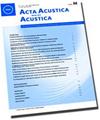New Investigations into Measurement Techniques Using the Pendulous Hammer to Assess Acoustic Insulation in Relation to User-Generated Noise in Residential Buildings
Q1 Arts and Humanities
引用次数: 0
Abstract
With the release of the revised version of the Swiss standard SIA 181:2006 "Protection Against Noise in Buildings", a measurement technique was introduced for simulating user-generated noise in bathtubs, shower cubicles, wash basins etc. employing a pendulous hammer. Despite the undoubted advantages of the measurement method, over the past few years questions have increasingly been raised regarding various issues involved in its use. The characteristics of the pendulous hammer are insufficiently well specified in the standard and a procedure specifying a periodic check of the instrument is lacking. The measurement method itself is described in inadequate detail, so that (for example) depending on the choice of the excitation, potentially very diff erent results may be obtained. In addition, no information is given regarding the measurement uncertainty. The standard gives level corrections for diff erent excitation scenarios. This allows a comparison of the diff erence between the level of the original noise and that generated by the pendulous hammer. The validity of these level corrections is now, to a certain extent, being challenged. In addition, it has been suggested that – depending on the constructional details - the airborne noise emitted by acoustic radiation from the component under investigation is excessive, thereby potentially falsifying the measured values. These issues have been investigated by Empa and, based on a comprehensive set of laboratory and field measurements, clarified. Measurement protocols are given for various components, and the measurement uncertainty has been evaluated. The eff ect of airborne noise has been shown to be acceptable for tests conducted in accordance with the SIA 181 standard. Sufficient measurement data is now available to allow the level corrections to be determined. Finally, specifications for the pendulous hammer itself have been formulated.用摆锤测量技术评价住宅建筑中用户产生的噪声的隔声性能的新研究
随着修订的瑞士标准SIA 181:2006“建筑物噪音保护”的发布,引入了一种测量技术,可以使用摆锤模拟浴缸,淋浴间,洗脸盆等用户产生的噪音。尽管测量方法具有无可置疑的优点,但在过去几年中,关于其使用所涉及的各种问题越来越多地提出了问题。标准中对摆锤的特性规定得不够好,而且缺乏规定仪器定期检查的程序。测量方法本身的描述不够详细,因此(例如)取决于激励的选择,可能会获得非常不同的结果。此外,没有给出有关测量不确定度的信息。该标准给出了不同激励情况下的水平校正。这样就可以比较原始噪声和摆锤产生的噪声之间的差异。这些水平修正的有效性现在在一定程度上受到挑战。此外,有人认为,受调查的构件的声辐射所发出的空气噪声过大,因此可能会伪造测量值,这取决于结构细节。环境规划署对这些问题进行了调查,并根据一套全面的实验室和实地测量结果予以澄清。给出了不同组分的测量方案,并对测量不确定度进行了评定。根据SIA 181标准进行的测试显示,空气中噪音的影响是可以接受的。现在有足够的测量数据来确定水平修正。最后,制定了摆锤本身的规格。
本文章由计算机程序翻译,如有差异,请以英文原文为准。
求助全文
约1分钟内获得全文
求助全文
来源期刊
CiteScore
2.60
自引率
0.00%
发文量
0
审稿时长
6.8 months
期刊介绍:
Cessation. Acta Acustica united with Acustica (Acta Acust united Ac), was published together with the European Acoustics Association (EAA). It was an international, peer-reviewed journal on acoustics. It published original articles on all subjects in the field of acoustics, such as
• General Linear Acoustics, • Nonlinear Acoustics, Macrosonics, • Aeroacoustics, • Atmospheric Sound, • Underwater Sound, • Ultrasonics, • Physical Acoustics, • Structural Acoustics, • Noise Control, • Active Control, • Environmental Noise, • Building Acoustics, • Room Acoustics, • Acoustic Materials and Metamaterials, • Audio Signal Processing and Transducers, • Computational and Numerical Acoustics, • Hearing, Audiology and Psychoacoustics, • Speech,
• Musical Acoustics, • Virtual Acoustics, • Auditory Quality of Systems, • Animal Bioacoustics, • History of Acoustics.

 求助内容:
求助内容: 应助结果提醒方式:
应助结果提醒方式:


